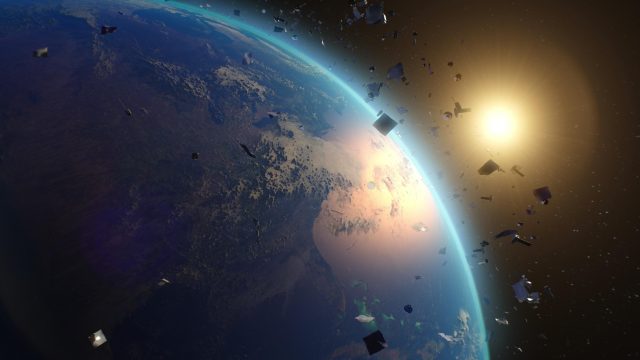The Milky Way Might Never Become An Elliptical Galaxy
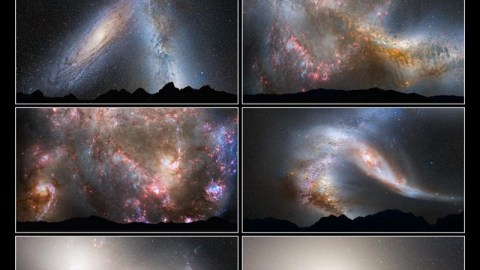
Even after our merger with Andromeda, we might retain our spiral shape for trillions of years.
You probably don’t think about it very often, but the Milky Way galaxy won’t remain in its present, undisturbed state for very long. Our Local Group is dominated by just two main galaxies — ourselves and Andromeda — with some ~60 other smaller galaxies gravitationally bound by our mutual gravitation. Over the past 13.8 billion years, a number of minor and major mergers have taken place, with numerous episodes of star formation and gas accretion having occurred in our neighborhood, leading to the evolved galaxies we have nearby today.
But cosmic evolution doesn’t just stop; this evolution is continuous. Over the next 4 billion years, the Milky Way and Andromeda will approach one another, gravitationally influence each other, and eventually, after a complex series of interactions, merge together. When major galaxies merge, they trigger a burst of new star formation, create winds, and expel gas. It’s led many, over the past few decades, to conclude that our eventual post-merger fate, already known as Milkdromeda, will evolve into a giant elliptical galaxy.
Only, that conventional wisdom is almost certainly wrong, and practically every researcher at the forefront of galaxy evolution understands why. Here’s the science behind our ultimate fate.

If you want to form an elliptical galaxy, there are two theoretical ways to make it happen.
- Monolithic collapse. The first scenario ever developed that could successfully explain elliptical galaxy formation has also been one of the most resilient. Quite simply, monolithic collapse conjectures that a large mass of gas-rich matter, either initially or very early on, collapses under its own gravity. This leads to an enormous burst of star formation, strong galactic winds, and the ejection of much of the remaining matter. After this event is over, the stars that formed will remain and age, and only nearby gas that later infalls contributes to future star formation.
- Hierarchical mergers. The major alternative to monolithic collapse, this scenario conjectures that most of the early galaxies that form are small, spiral-like, and grow by accretion and mergers. When major mergers — that is, mergers between two approximately equal-mass galaxies — occur, this can lead to incredibly rich star-formation events. The orbits of the stars become randomized; the gas gets ejected; and we wind up with a gas-poor or gas-free galaxy whose stars swarm around the center like angry bees in a beehive.
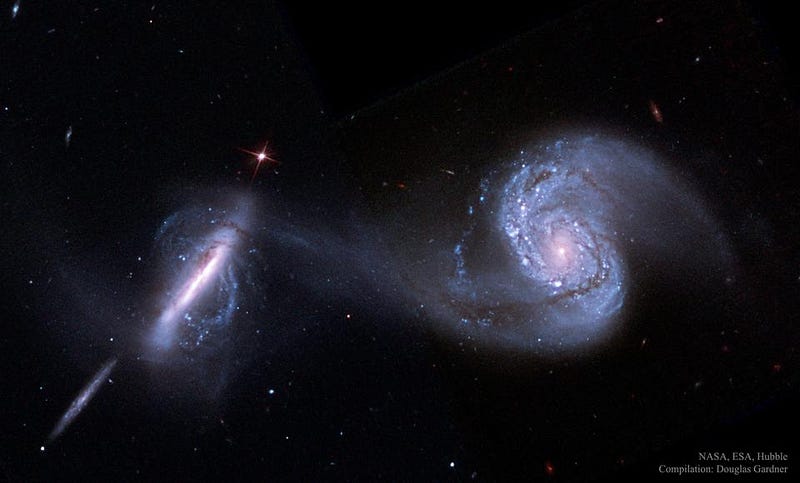
If we want to know which scenario represents the majority of elliptical galaxies in the Universe, what we have to do is examine these types of galaxies in great detail to see which story fits the evidence in a superior fashion.
The first thing we can do is look at what types of galaxies are out there, and how rare or common they are. Galaxies commonly exist in three different places:
- field galaxies, which are relatively isolated from other galaxies,
- outskirt galaxies, like our own, which are in small groups or on the edges of clusters,
- or cluster galaxies, which are primarily found towards the center of rich, large clusters of galaxies.
In the field, almost every galaxy is a spiral of some type. Some galaxies are irregulars — largely the ones that are in the process of interacting — but spirals are exceedingly common and ellipticals are relatively rare. The story is similar for outskirt galaxies as well: spirals dominate, ellipticals are rare (but they do exist, and are less uncommon than they are in the field). But in the hearts of rich clusters, there’s a healthy split. A substantial fraction of the galaxies found inside a rich cluster, like Virgo or Coma, are ellipticals, and the fraction of ellipticals versus spirals increases the higher-mass and closer to the center of the cluster you look.
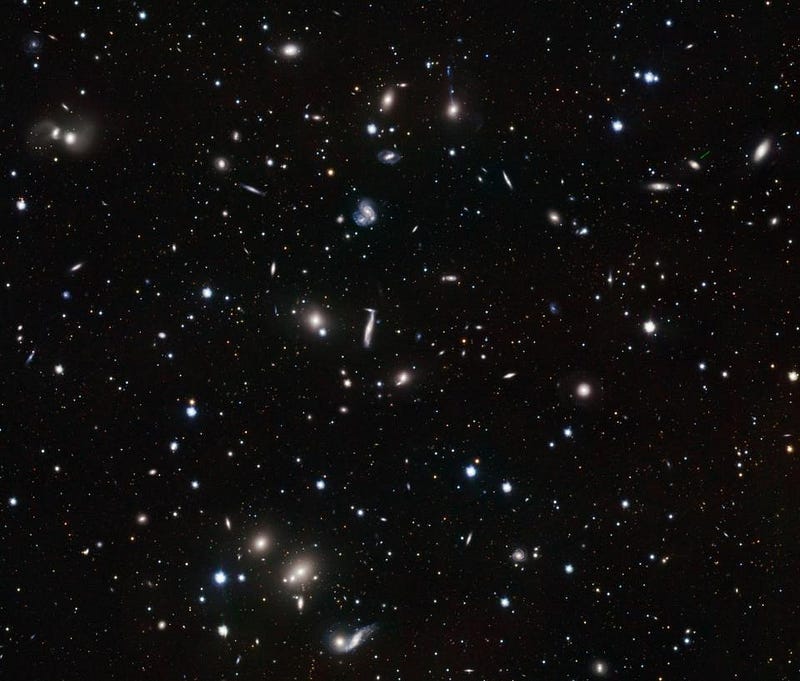
That’s a clue towards the answer, but it’s not a decisive piece of evidence on its own. Galaxies that exist in rich, dense, massive clusters are far more likely to experience major mergers — both in their distant past and in recent cosmic history — than galaxies in the field or in small groups or cluster outskirts.
On the other hand, galaxies that exist in these massive environments arose from a region of space that had, initially, a much larger “seed” to grow from. The most overdense initial regions grow to become the richest regions of structure later on, and so they attract more and more mass into them at early times.
In other words, galaxies that exist in rich clusters are expected to both reach large masses at early times so that they’re capable of undergoing monolithic collapse, as well as are more likely to collide and merge with other large galaxies. Simply looking at where these galaxies are located doesn’t give us enough information to determine which of these two scenarios is more responsible for the elliptical galaxies we see in the Universe.

But looking inside these elliptical galaxies, at the stars inside, can provide a tremendous clue. Whenever we take in the light from a galaxy, we can break it up into its various wavelengths. Rather than perform spectroscopy, which can be too granular for these purposes, we can examine these galaxies by looking at them photometrically. That basically takes all of the starlight from the galaxy, and asks questions like:
- How much of this light is ultraviolet?
- How much is blue?
- How much is green, yellow, orange, or red?
- How much is infrared?
- How much gas is present, and how much dust is present?
Based on the answers to these questions, we can learn about the stars that exist inside each of these galaxies. This information typically infer where and when the largest episodes of past star-formation were, whether star-formation has been ongoing continuously or occurred sporadically, and whether gas continues to flow in and form new stars, or — like many elliptical galaxies — the stellar population inside indicates that it hasn’t formed new stars for billions of years: a “red and dead” galaxy.
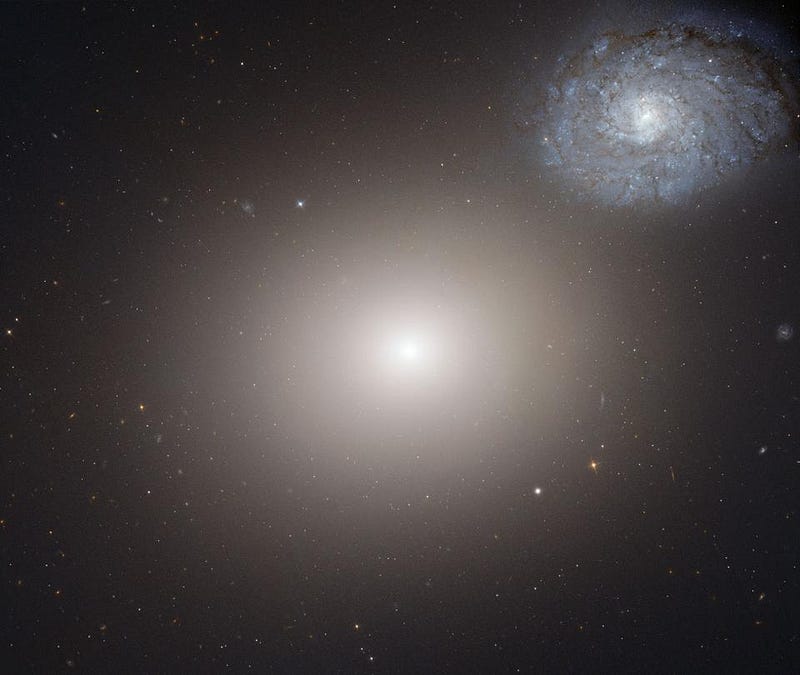
So, with all of the astronomical data we’ve accumulated, what have we learned about the elliptical galaxies that exist in our Universe? A lot of things, some of which are quite surprising.
- Almost all of them formed the overwhelming majority of their stars a very long time ago, but have had no major episodes of star formation for the past 9-to-11 billion years.
- While most ellipticals don’t continue to accumulate gas and form new stars, the second most common happenstance is for gas to continue to trickle in and slowly, but continually, form new stars as a result.
- And that — with the advent of telescopes that can see back in time to the Universe’s infancy — major mergers of large, gas-rich galaxies were common when the Universe was just 2-to-3 billion years old, triggering bursts of star formation but also tremendous stellar winds.
In other words, most of the elliptical galaxies that exist today came about from a combination of monolithic collapse and numerous major mergers from within a rich cluster, that the winds from intense star formation episodes drive the gas out, and that unless new gas gets drawn in, these ellipticals stop forming stars by the time the Universe is just ⅓ its present age.

But what happens to the other galaxies in the Universe? If you don’t grown and merge to form an elliptical galaxy inside a rich cluster early on, does that mean you’ll never become an elliptical? Or, to put it another way, what about the hierarchical merger scenario that favors the late-time mergers of galaxies?
As it turns out, this does occur as well. In fact, early on in the young Universe and particularly in clusters, mergers occurred rapidly and frequently, and likely played a major role in the creation of the majority of giant ellipticals. But in the Universe’s outskirts — and in the sparsely populated regions between the rich clusters — you’re far more likely to see the slow, gradual accumulation of matter. Gas and satellite galaxies get drawn into their larger neighbors; major mergers are relatively rare, and spectacular when they do occur.
You’ve probably, in fact, seen either an animation or a multi-panel schematic showing the prototypical template for what happens when two similarly sized spiral galaxies merge together.
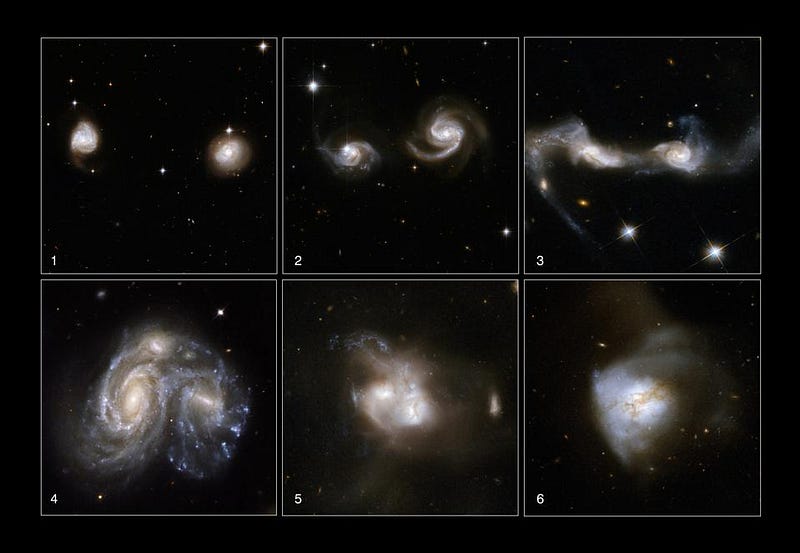
A lot of this is correct. In every merger between two spiral galaxies of significant mass, the following things pretty much always happen:
- the two galaxies gravitationally interact,
- which causes tidal forces (where the near side experiences a greater gravitational attraction than the far side of each galaxy),
- which causes gas clouds to compress,
- leading to gas stripping and star formation,
- which leads to stellar winds,
- which can wind up ejecting significant amounts of gas,
- all while the stellar orbits evolve in a myriad of directions.
The picture that’s most often painted — and perhaps, 20 years ago, one could have argued it was the most likely picture — is one where all of the gas in both galaxies either forms stars or gets ejected, the orbits of all the stars get randomized in some fashion, and an elliptical galaxy is the end result.
But even though this is a common picture, even among astronomers, the truth is that most mergers — even most major mergers — don’t result in an elliptical galaxy in the end.
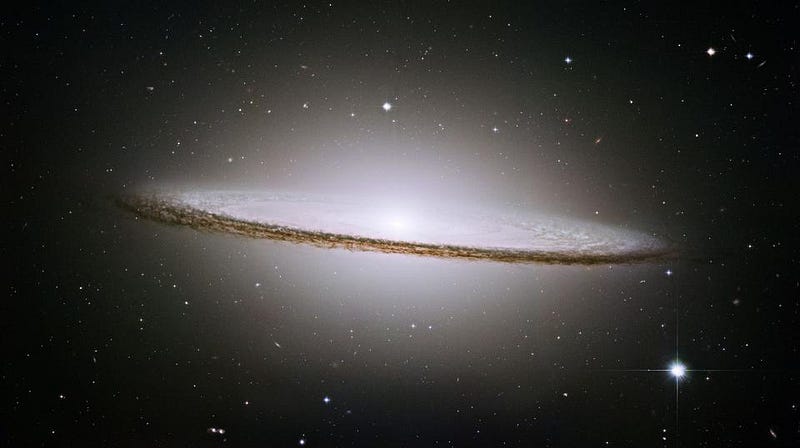
Instead, two colliding spiral galaxies are far more likely to produce something that is still quite spiral like. It might have an elliptical component to it (like a central bulge of stars), but a single major merger is unlikely to shed enough angular momentum — where most of the galaxy rotates around one particular axis — to eliminate the disk component arising from one or both of the progenitor galaxies.
Many of the galaxies in our night sky, in fact, like Centaurus A or the Sombrero Galaxy (Messier 104, above), exhibit properties of both spiral and elliptical galaxies: where they have a significant ellipsoidal halo of stars around them, but also have a prominent stellar disk with dust lanes in them.
The Milky Way and Andromeda, as far as spiral galaxies go, both have small central bulges, a prominent disk structure, and are relatively gas poor. But their angular momentum is so great that in the overwhelming majority of simulations, we don’t wind up with an elliptical galaxy at all. In fact, the best one can say about two roughly equal-mass spiral galaxies that merge is that they may occasionally form an elliptical galaxy, but — like the nearby elliptical NGC 3610 (below) — but that such outcomes are rare, and that a disk and even some gas will persist.
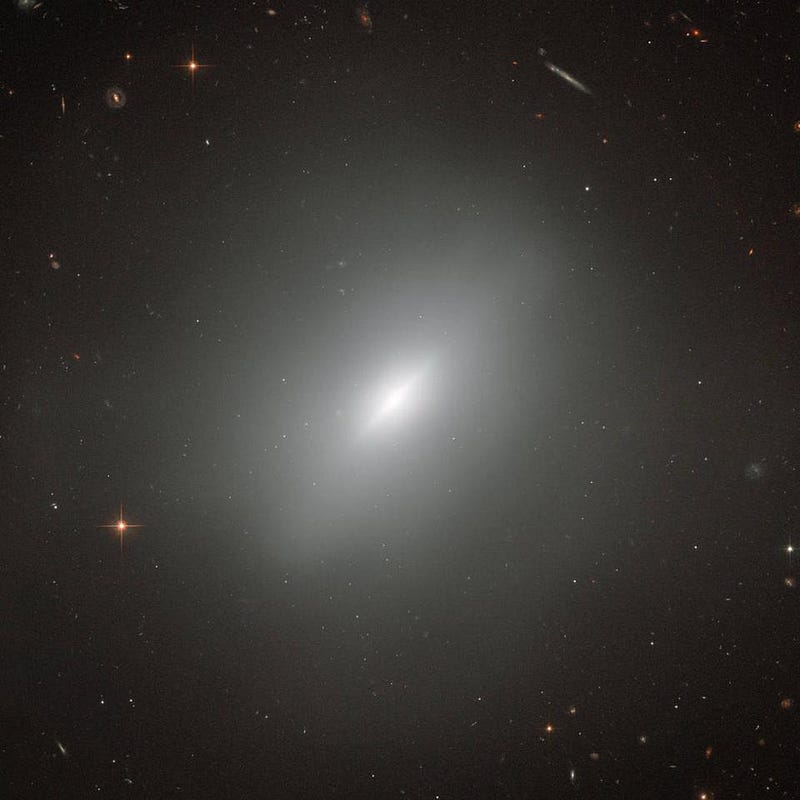
So what’s likely to happen to our Milky Way over the next few billion years? As it merges with Andromeda, it’s likely to trigger multiple waves of new star formation in both galaxies, generating young stars, powerful stellar winds, and ejecting a significant fraction of the gas. The orbits of many billions of stars will be perturbed, and we’ll gain a large, ellipsoidally-shaped bulge of stars.
But the enormous amounts of angular momentum in the disks of the Milky Way and Andromeda will be conserved, and the post-merger galaxy — which we can still call Milkdromeda, if we like — is still likely to maintain a disk, to still possess gas and dust, and to still continue to form new stars along the rolling density waves that propagate through that disk, creating the familiar spiral arm appearance of these galaxies.
We will continue to slowly form new stars for many trillions of years. Our Local Group won’t become “red and dead” for many times the present age of the Universe. And, perhaps most importantly, we’ll still have a Milky Way-like feature in the night sky of whatever planets are around in the far future. There may come a day where our spiral features are no more. But since the turn of the century, we’ve learned that day won’t come when the Milky Way and Andromeda merge, but rather much farther out into the distant future.
Starts With A Bang is written by Ethan Siegel, Ph.D., author of Beyond The Galaxy, and Treknology: The Science of Star Trek from Tricorders to Warp Drive.





